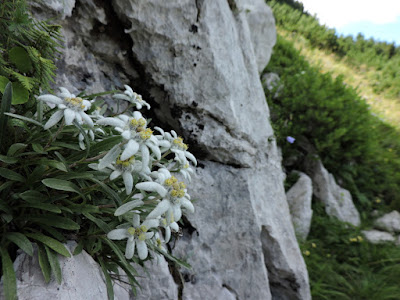 |
| Leontopodium alpinum, Mt. Snežnik, 30th July 2016. The most typical alpine representative of Snežnik's flora. |
 |
| View on Mali Snežnik (1694 m), covered with Pinus mugo, 30th July 2016 (pic by Sara Cernich). |
 |
| Campanula cochleariifolia, Mt. Snežnik, 30th July 2016. |
 |
| Snežnik's summit with the mountain hut, 30th July 2016. |
 |
| Golden Eagle Aquila chrysaetos (adult), Mt. Snežnik, 30th July 2016 (first pic by Sara Cernich). |
 |
| Aster alpinus, Mt. Snežnik, 30th July 2016. Another typical representative of alpine flora on Snežnik. Found sparsely around the summit. |
 |
| Edraianthus graminifolius, Mt. Snežnik, 30th July 2016. Illyric/Balkanic species, in Slovenia being present on just a few locations (Snežnik is the stronghold). |
 |
| Scabiosa silenifolia, Mt. Snežnik, 30th July 2016. In Slovenia only present on Snežnik and in Kočevsko region. |
 |
| Linum julicum, Mt. Snežnik, 30th July 2016. Another typical alpine species with a disjunction on Snežnik. |
 |
| Achillea clavennae, Mt. Snežnik, 30th July 2016. Common high-altitude species, present throughout the Alps and on Snežnik too. |
 |
| Snežnik's northern slopes, 30th July 2016. |
 |
| Mountain pine Pinus mugo, Mt. Snežnik, 30th July 2016. The very dense stands make walking on abandoned paths quite challenging. Here during the descend to Snežnik's north-east slopes. |
 |
| Mountain pine Pinus mugo (young cones), Mt. Snežnik, 30th July 2016. |
 |
| Leontopodium alpinum, Mt. Snežnik, 30th July 2016. Beautiful and very common around the summit. On Snežnik grow the largest and most beautiful specimen I've ever seen. |
 |
| Dianthus barbatus, Mt. Snežnik, 30th July 2016. |
 |
| Eastern slopes of Mt. Snežnik, 30th July 2016. Following an old hunter's path through the dense mountain pines Pinus mugo. |
 |
| Alpine Salamander Salamandra atra, Mt. Snežnik, 30th July 2016. |
 |
| Beech Fagus sylvatica, Mt. Snežnik, 30th July 2016. An old tree with several such holes in it. |
 |
| Beech (mast) Fagus sylvatica, Mt. Snežnik, 30th July 2016. Looks like a good year for beech crop - also noticeable by the high number of Edible Dormice Glis glis present in the forest at night. |
 |
| Fungi sp., Mt. Snežnik, 30th July 2016. Amazing fungal formations are very common on fallen logs and some standing trees (pity I can't ID them). |
 |
| Fomes fomentarius, Mt. Snežnik, 30th July 2016. A common fungus growing on dead and decaying beech Fagus sylvatica. Note the woodpecker's fresh feeding hole (most probably Black's or White-backed's). |
 |
| Beech Fagus sylvatica "tower", Snežnik, 30th July 2016. These were perhaps the larges fungi I've ever seen. |
 |
| View south-east towards Croatia, Snežnik, 30th July 2016. Forests as far as the eye can see! |
A few days ago I was on mount Snežnik (1796 m) in SW Slovenia with a couple of friends. Snežnik is the highest non-alpine peak in Slovenia, surrounded by extensive mixed forests (Abieti-Fagetum). The summit has a strong alpine influence, with many plants and birds, more usually associated with the Alps. For more info about the flora and biogeography of this mountain, see some previous posts here and here.
We first ascended Snežnik from its south-western slopes, then descended to the east and ascended again to the summit (after getting lost!). So we basically climbed on the mountain twice in a day, from two different directions. This way we discovered some rarely-visited (if at all!) parts of the forest (primeval patches), where we found an Alpine Salamander Salamandra atra, tons of dead wood & amazing fungi. On the bird front, the most interesting were a Golden Eagle Aquila chrysaetos (perched on a cliff) and several Ring Ouzels Turdus torquatus around the summit. In the thick mountain pine stand (Pinetum mugi dinaricum) some other birds were obvious: Lesser Whitethroat Sylvia curruca, Chiffchaff Phylloscopus collybita, Crossbill Loxia curvirostra & Bullfinch Pyrrhula pyrrhula. During the final, evening descend we first heard and then saw 3 different Ural Owls Strix uralensis (also singing "in concert") and heard a distant Pygmy Owl Glaucidium passerinum. The forest was full of Edible Dormice Glis glis (delivering all sorts of odd noises) that made us happy. Their numbers depend on beech mast production and consequently, a large density of dormice will support greater numbers of their main predators: owls. In these forests Ural Owl is the most typical dormouse-hunter, so in the coming months we will probably notice an increase in this species as well.






